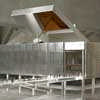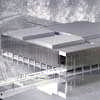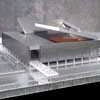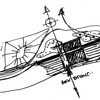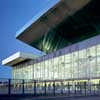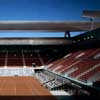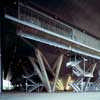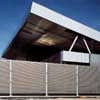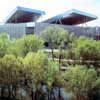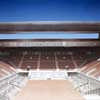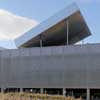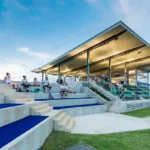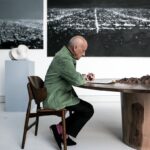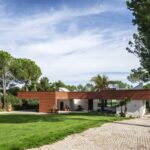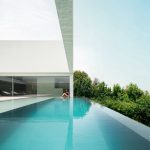Madrid Olympic Tennis Centre, Spanish Sports Building, Venue, Photo, Design
Olympic Tennis Centre Madrid
Sports Building in Spain – design by Dominique Perrault architects
19 Nov 2009
Madrid Olympic Tennis Center
MADRID’S OLYMPIC TENNIS CENTRE BY DOMINIQUE PERRAULT
Opened 8 May 2009
Design: Dominique Perrault, architects
Madrid’s Olympic Tennis Centre, designed by leading French architect Dominique Perrault, was inaugurated on 8 May 2009. Described as one of the world’s most advanced sports facilities, the venue hosted some 200 players during the Madrid Open tennis (9-17 May 2009) and aims to reinforce the Spanish Capital’s candidature for the 2016 Olympics.
Dominique Perrault, best known for such pioneering buildings as the Berlin Velodrome and Olympic Swimming Pool and the Bibliothèque nationale de France, has offices in Paris, Madrid and Luxembourg. He has recently also delivered the Ewha Women’s University, in Seoul, South Korea, the tower hotel Me in Barcelona and the Court of Justice of the European Communities in Luxembourg. The firm is currently working on a variety of other major projects ranging from office buildings to hotels and urban planning programmes such as the Fukoku Tower in Japan, the San Pellegrino thermal baths in Italy and office and mixed-use buildings in France.
Madrid Olympic Tennis Centre
With a plot area of 16.5 hectares (40.77 acres), the site is located on a former slum housing area, previously a wasteland in the middle of a busy motorway and train network. The 100,000 square metre (1.07 million sq ft) built project includes the “magic box” with three indoor /outdoor courts with covered area for 20,000 spectators (12,000, 5,000 and 3,000 respectively), 16 outdoor courts, five courts with a covered area for 350 spectators each, six practice courts, a pool, headquarters for the Madrid Tennis Federation, a tennis school, clubhouse, press centre, stadium boxes and other private areas and restaurants. Built areas, made of steel, aluminium, concrete and glass, are organized around a vast artificial lake over which volumes of varying sizes are scattered, like islands or fragments of nature beckoning strollers. A system of footbridges opens numerous paths through these volumes, offering spectacular new perspectives and connecting the “magic box” with the San Fermin neighbourhood and the Manzanares river Park, designed by Ricardo Bofill.
The “magic box” design superimposes two worlds. At the lake level (level -2), there are spaces for the players and the support services: training, receptions for VIPs, press centre, technical installations. Eight metres above, at the street level (level 0), there are spaces for the public and services aimed at the audiences on match days or during other events. Inside, the tennis arenas are adapted to the different uses of the complex.
The roofs of the three indoor/outdoor courts are giant mobile slabs mounted on hydraulic jacks, which serve to partially or totally open the three roofs to allow forpassage of air and sunlight or close them to avoid exposure to the rain or other hazardous weather conditions.
The three aluminium clad roofs together provide a combination of 27 different opening positions. The roof of the central court, which measures 102 m x 70 m and which weighs some 1,200 tons, can have a vertical opening reach of up to 20 m while the horizontal opening can slide as much as its width.
Both the smaller stadiums roofs measure some 60 m x 40 m and can open vertically up to 25 degrees. They can also slide horizontally, leaving the inside of the stadiums completely open to the sky. The movements of the roofs on the scale of the immense structure throw a giant living shadow onto the landscape.
Even in the worst weather conditions, Madrid’s Olympic Tennis Centre can hold a minimum of three simultaneous matches, the only tennis premises in the world to offer such flexibility. This versatility allows it not only to host almost any kind of sports meeting, but also a significant number of other events, such as concerts, political meetings, fashion shows, etc.
Perrault’s signature metallic mesh, which envelops the magic box filters, is reflective or opaque, depending on the time of the day. In daylight, it shimmers. At night, light radiates from within, signalling the events underway inside. A special mesh design has been newly developed for this project. The metal mesh panels of the main building (25 m high x 7.20 m wide), have never previously been manufactured to such scale and are therefore pioneering in themselves.
The new iconic landmark is endowed with a large park, above the water level, allowing it to be a public space to be used by pedestrians day or night, whether or not competitions are being held. The area, which will have parking for 3,200 cars, is linked to the Madrid Cycle Ring Routes and has an underground station within a five minute walking distance.
The architecture of the “magic box” changes the configuration of the city, standing as a powerful signal, a permanent new landmark, and a new entrance.
Olympic Tennis Centre Madrid – Building Information
International competition, winning project May 2002, completion May 2009
client: Madrid Espacios y Congresos, Madrid, Spain
contact: Madrid Espacios y Congresos, C/Ribera del Sena s/n 28042 Madrid, tel : +34 91 722 04 00, fax : +34 91 721 06 07
architect: Dominique Perrault Architecte, Paris
engineering: Perrault Projets, Paris (architectural engineering) ; TYPSA, Madrid (structure and installations)
project manager: LKS, Madrid
location: Parque del Manzanares, Madrid, Spain
site area: 16.5 ha (40.77 acres)
built area: 100,000 m²
built volume: 1,051,680 m³ (225,000 m³ tennis indoor and 826,680 m³ Caja Magica)
beginning of conceptual design: 2002
beginning of construction: Apr 2006
construction period: 3 years
estimated project cost: € 150,000,000 excluding taxes
photos: © Perrault Projets / Adagp
Olympic Tennis Centre Madrid – Programme
In the prospect of being a candidate for staging the Olympic Games in 2016, the Spanish capital has begun a campaign to build spectacular facilities among the Olympic Tennis Centre. Working in an indistinct peripheral area, the issue at stake was not so much to design a building as to stage manage architectureand invent scenery.
The “magic box” concept encloses sports and multi-functional buildings but opens up and shapes itself to the varius uses projecting a changing and lively silhouette in the cityscape. Its mobile and vibrant skin filters the sunlight, serves as a windbreak and shelters the sports halls in a lightwight shell.
Water forms a lake to define a wide horizontal plane of reference, like a huge natural mirror. Islands ( pieces of dry or verdant nature depending on their irrigation ) invite to the pleasure of calm walks or sports activities. The walks proceed over footbridges, pontoons and wide places, opening viewpoints on the surrounding scenery.
All told an architectural landscape that flows and ripples like a garment, a place for strolling and having fun, a venue that is alive day and night.
Madrid Olympic Tennis Centre images / information from Dominique Perrault
Dominique Perrault Architects, Paris
Location: Madrid, Spain
Madrid Buildings
Contemporary Madrid Architecture
Madrid Architecture Walking Tours by e-architect
Madrid Stadium : Bernabeu
Caixa Forum
Herzog de Meuron
Caixa Forum Madrid
Barajas Airport
Architects: Richard Rogers Partnership
Madrid Airport Building
Architects: Estudio Lamela
Madrid Stadium : Bernabeu
Comments / photos for the Madrid Olympic Tennis Centre Architecture page welcome
Website: Olympic Tennis Centre Madrid

